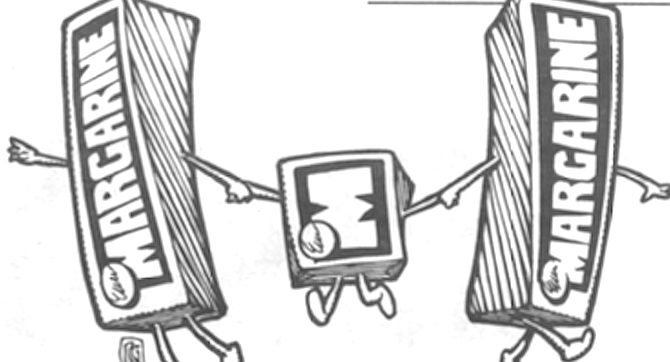 Facebook
Facebook
 X
X
 Instagram
Instagram
 TikTok
TikTok
 Youtube
Youtube

Dear Matthew Alice: Why are margarine and butter sold in different shapes on the East and West Coasts? In the West, the cubes are short and fat, while on the East Coast they are long and slender. Even the butter dishes in new refrigerators reflect this difference. I have asked grocery store managers on both coasts. Although they are aware of the different shapes, they have no idea as to why. You are my last hope. — Perplexed, San Diego
One more burning public issue that’s gone sorely underreported. I mean, what’s a person to do when they move to Delaware and suddenly butter doesn’t fit into the trusted family fridge? A few months ago we ripped the cover off the East Coast/West Coast king-size bed anomaly, and now this. Will we ever be one united nation? I’m not optimistic.
Today’s modern manufacturer of butter-wrapper filling machinery is smart enough to offer flexibility. So we’ll have to go back, back, back in time for the answer to this one. It has to do with where the early butter-packaging machinery came from. The East Coast imported German machinery, which produced long, thin quarter-pounders. West Coast equipment was more often Danish. Shorter, fatter. It’s just some sort of weird tradition. If you live in St. Louis, I don’t know what you do.


Dear Matthew Alice: Why are margarine and butter sold in different shapes on the East and West Coasts? In the West, the cubes are short and fat, while on the East Coast they are long and slender. Even the butter dishes in new refrigerators reflect this difference. I have asked grocery store managers on both coasts. Although they are aware of the different shapes, they have no idea as to why. You are my last hope. — Perplexed, San Diego
One more burning public issue that’s gone sorely underreported. I mean, what’s a person to do when they move to Delaware and suddenly butter doesn’t fit into the trusted family fridge? A few months ago we ripped the cover off the East Coast/West Coast king-size bed anomaly, and now this. Will we ever be one united nation? I’m not optimistic.
Today’s modern manufacturer of butter-wrapper filling machinery is smart enough to offer flexibility. So we’ll have to go back, back, back in time for the answer to this one. It has to do with where the early butter-packaging machinery came from. The East Coast imported German machinery, which produced long, thin quarter-pounders. West Coast equipment was more often Danish. Shorter, fatter. It’s just some sort of weird tradition. If you live in St. Louis, I don’t know what you do.
Comments